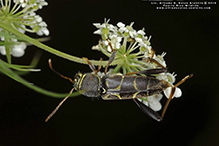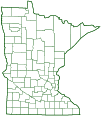longhorned beetle
(Neoclytus mucronatus mucronatus)
Conservation • Description • Habitat • Biology • Distribution • Taxonomy
Conservation Status |
|
|||||||
| IUCN Red List | not listed |
|||||||
| NatureServe | NNR - Unranked |
|||||||
| Minnesota | not listed |
|||||||
Description |
||
Neoclytus mucronatus is a small to large round-necked long-horned beetle. It occurs in the United States from Massachusetts to Florida west to Wisconsin, Nebraska, and Texas, in southern Ontario Canada, and in northern Mexico. It has not been reported in Minnesota. The larvae are rarely seen. They feed under the bark of dead and dying hickory at first, then move into the heartwood. They also infest hackberry and elm, and rarely pine. Adults are found in summer in deciduous and mixed woodlands. Adults are 5⁄16″ to ⅞″ (7.5 to 23 mm) in length and are densely covered with short, velvety hairs. They are dark brown or black with reddish-brown areas and yellow markings. The body is constricted between the thorax and the abdomen, forming a distinct rounded “neck”. The head is reddish-brown and black. There is a narrow yellow band on the top and sides of the head behind the compound eyes. The face is slanted forward or nearly vertical, and there are two vertical yellow stripes between the eyes. The small antennae-like structures (palpi) emerging from the lower jaws (maxillae) are blunt at the tip, not pointed. The antennae are long, at least half as long as the body. Each compound eye is notched at the base of the antenna but the antenna base is not surrounded by the compound eye. The exoskeletal plate covering the thorax (pronotum) and the hardened wing covers (elytra) are mostly black. The pronotum is rounded and widest near the middle. It is black with a large reddish-brown area on each side of the middle. A thin band of yellow hairs on the margins encircles the pronotum, broken only in the middle just behind the head. There is no yellow band across the middle. The small plate between the bases of the elytra (scutellum) is black at the base with a broad, bright yellow margin. Each elytron has four narrow bands of yellow hairs. The first band, the one nearest the base, is bordered below by a broad reddish-brown area. The first and second bands are joined in the middle by a longitudinal stripe of white hairs. Together with a longitudinal yellow stripe on the abdomen, the first and second bands almost form a circle. The third band is a forward-pointing arc. The fourth band is almost straight across. There is a distinct spine at the tip of each elytron. The legs are mostly yellowish-brown. On the hind leg the third segment (femur) is mostly black, yellowish-brown just at the base, and has a pair of short but distinct spines at the tip. There is a single longer spine at the tip of the fourth leg segment (tibia). The last part of each leg (tarsus), corresponding to the foot, has five segments. The fourth segment is very short and is concealed within the broadened tip of the third segment, making the tarsus appear to have only four segments. |
||
Size |
||
5⁄16″ to ⅞″ (7.5 to 23 mm) in length |
||
Similar Species |
||
Habitat |
||
Deciduous and mixed woodlands |
||
Biology |
||
Season |
||
One generation per year: Summer |
||
Behavior |
||
Adults are attracted to light at night. |
||
Life Cycle |
||
|
||
Larva Food |
||
Larvae feed under the bark of dead and dying hickory at first, then move into the heartwood. They also infest hackberry and elm, and rarely pine. |
||
Adult Food |
||
|
||
Distribution |
||||
|
Sources |
|||
| 8/3/2021 | ||||
Occurrence |
||||
Not reported in Minnesota |
||||
Taxonomy |
|||
Order |
Coleoptera (beetles) | ||
Suborder |
Polyphaga (water, rove, scarab, long-horned, leaf, and snout beetles) | ||
Infraorder |
Cucujiformia | ||
Superfamily |
Chrysomeloidea (longhorn beetles and allies) | ||
Family |
Cerambycidae (longhorn beetles) | ||
Subfamily |
Cerambycinae (round-necked longhorn beetles) | ||
Tribe |
Clytini | ||
Genus |
Neoclytus | ||
| Species | Neoclytus mucronatus | ||
There are two subspecies of Neoclytus mucronatus. Only one, N. m. mucronatus, occurs north of Texas. |
|||
Synonyms |
|||
|
|||
Common Names |
|||
This species has no common name. The common name of the subfamily Cerambycinae is long-horned beetles, and it is applied here for convenience. |
|||
Glossary
Elytra
The hardened or leathery forewings of beetles used to protect the fragile hindwings, which are used for flying. Singular: elytron.
Femur
On insects and arachnids, the third, largest, most robust segment of the leg, coming immediately before the tibia. On humans, the thigh bone.
Maxillae
Paired mouth structures of arthropods located immediately behind the mandible and used for tasting and manipulating food. “Under-jaws”.
Palp
Short for pedipalp. A segmented, finger-like process of an arthropod; one is attached to each maxilla and two are attached to the labium. They function as sense organs in spiders and insects, and as weapons in scorpions. Plural: palpi or palps.
Pronotum
The exoskeletal plate on the upper side of the first segment of the thorax of an insect.
Scutellum
The exoskeletal plate covering the rearward (posterior) part of the middle segment of the thorax in some insects. In Coleoptera, Hemiptera, and Homoptera, the dorsal, often triangular plate behind the pronotum and between the bases of the front wings. In Diptera, the exoskeletal plate between the abdomen and the thorax.
Tarsus
On insects, the last two to five subdivisions of the leg, attached to the tibia; the foot. On spiders, the last segment of the leg. Plural: tarsi.
Tibia
The fourth segment of an insect leg, after the femur and before the tarsus (foot). The fifth segment of a spider leg or palp.
Visitor Photos |
|||||
Share your photo of this insect. |
|||||
| This button not working for you? Simply email us at info@MinnesotaSeasons.com. Attach one or more photos and, if you like, a caption. |
|||||
Alfredo Colon |
|||||
 |
|||||
MinnesotaSeasons.com Photos |
|||||
|
|||||

Slideshows |
||

Visitor Videos |
|||
Share your video of this insect. |
|||
| This button not working for you? Simply email us at info@MinnesotaSeasons.com. Attach a video, a YouTube link, or a cloud storage link. |
|||
Other Videos |
|||

Created: 8/3/2021
Last Updated:


